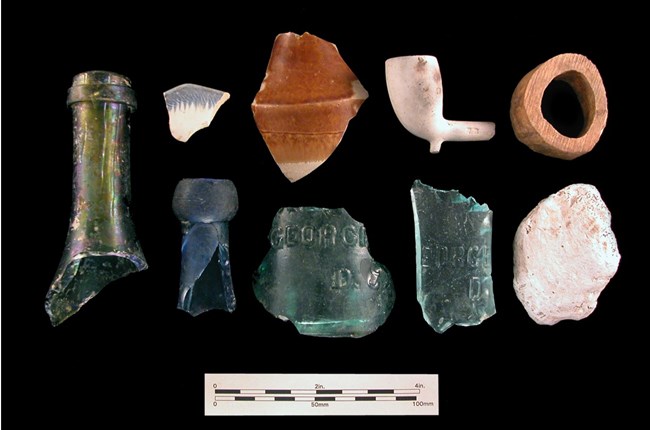Part of a series of articles titled History and Archeology of the District of Columbia Monumental Core.
Article
Archeology in the Monumental Core: Part 1
by Charles LeeDecker
There has been relatively little archeological work in the Monumental Core as archeologists have generally assumed (1) much of the landscape is composed of landfill deposits of little archeological significance and (2) the natural landscapes that might contain prehistoric or early historic remains have been obliterated by urban development and formal landscaping of the park lands. However, over the past few years, a number of development projects in the Monumental Core have allowed archeologists to re-examine these assumptions and to document an archeological record of some historical interest.

NPS
Dredged material from the Potomac is perhaps the best documented and primary source of fill for the Monumental Core lands, but the engineers and landscape architects of the day used just about any source of material that was available. Some of the massive earthen fill deposits that have been documented archeologically are obviously typical of redeposited river bottom silts, in their soil characteristics and absence of artifacts. But many other sources of fill were used, including soil excavated from the basements of major federal buildings and material from the grading of streets. Other fill sources included streetsweepings and deposits that closely resemble the refuse commonly found on the city’s nineteenth-century residential lots. The latter includes architectural rubble, coal, oyster, bone and household items such as bottles and ceramic vessels. These deposits have been documented in localized areas in President’s Park (LeeDecker 2006) and the site of the National Museum of African American History and Culture (NMAAHC) and on the Washington Monument Grounds (LeeDecker et al. 2008).
Geoarcheological investigations for a visitor screening facility at the Washington Monument documented massive, fairly uniform deposits of earthen fill that seem to be dredged riverbottom silts. These fills ranged from roughly 6 to 20 feet, and were deposited during the 1880s, when construction of the monument was completed and the first formal landscape was built. But a surprising result of this study was the discovery of a well preserved, natural landscape beneath the fill layer. This landscape was the landform overlooking the original confluence of Tiber Creek and the Potomac River. And beneath it was an older landscape surface or paleolandscape that was recognizable by a blanket of loess (wind-deposited soil) that formed during the Younger Dryas climatic episode, roughly 10,850 to 9550 BC. (LeeDecker and Wagner 2011).
Investigations at the NMAAHC site revealed fill soil layers that were more complex and variable, reflecting a multitude of historical events that have shaped this area of the city since the late 18th century. In one area of the site, the basal soil was a dark, organic layer of “marsh muck” representing the swampy land along Tiber Creek. Some fill sequences seem to embody events associated with construction and abandonment of the Washington City Canal. As in President’s Park, many areas contained concentrations of brick rubble and household refuse, deposited during the 1870s. Other deposits embody events of the late 19th and early 20th centuries, including remnants of carriageways from the 1880s or 1890s and the surface of a tennis court built in the 1930s (LeeDecker, Kraus and Kuhn 2008).
Evidence of a paleolandscape has been found at many locations throughout the city and the surrounding region. Elsewhere in the Monumental Core, some evidence of the paleolandscape have been documented during a geoarcheological study for the National Mall Turf and Soil Reconstruction Project. Much of the National Mall can be characterized by soil columns composed of varying amounts of fill over truncated natural soils. But despite the complex and well-documented landscape history of the National Mall, patches of prehistoric and early historic landscapes have been preserved, including tidal flats associated with Tiber Creek, upland landforms and a possible paleolandscape (LeeDecker 2010). While patchy evidence of a paleolandscape has been widely documented, no artifacts have yet been found in association with this ancient landscape.
References
LeeDecker, Charles H. 2006. Geoarcheological Investigations for the Ellipse Rehabilitation Project, President’s Park, District of Columbia. Prepared for the National Park Service, National Capital Region by The Louis Berger Group, Inc., Washington, D.C.
LeeDecker, Charles H., Lisa Kraus, and Patti Kuh. 2008. Phase II Archaeological Investigation for the National Museum of African American History and Culture, District of Columbia. Prepared for Smithsonian Institution, Office of Planning and Project Management, Washington, D.C., by The Louis Berger Group, Inc., Washington, D.C.
LeeDecker, Charles and Daniel P. Wagner. 2011. Geoarcheological Investigation for the Washington Monument Visitor Screening Facility, National Mall and Memorial Parks, District of Columbia. Prepared for the National Park Service, Denver Service Center, Denver, Colorado, and Beyer Blinder Belle, Washington, D.C., by The Louis Berger Group, Inc., Washington, D.C.
LeeDecker, Charles H., Lisa Kraus, and Patti Kuhn. 2008. Phase II Archaeological Investigation for the National Museum of African American History and Culture, District of Columbia. Prepared for Smithsonian Institution, Office of Planning and Project Management, Washington, D.C., by The Louis Berger Group, Inc., Washington, D.C.
LeeDecker, Charles H. 2010. Geoarcheological Investigations for the National Mall Turf and Soil Reconstruction Project National Mall and Memorial Parks, District of Columbia. Prepared for the National Park Service, Denver Service Center by The Louis Berger Group, Inc., Washington, D.C.
Last updated: April 17, 2020
